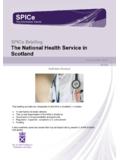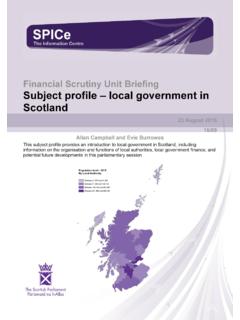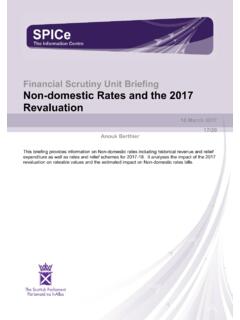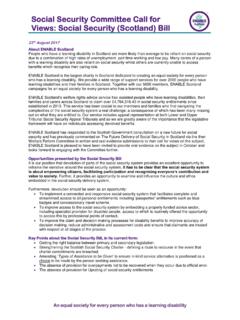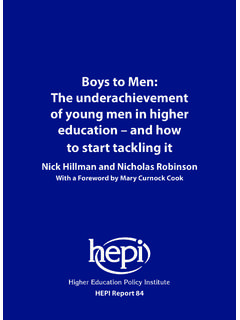Transcription of Gordon Lindhurst MSP - Scottish Parliament
1 1 Gordon Lindhurst MSP Convener Economy, Jobs and Fair Work Committee The Scottish Parliament Edinburgh EH99 1SP 02 June 2017 Dear Gordon , Thank you for you letter, dated 12 May 2017, requesting further information on the steps Skills Development Scotland (SDS) is taking to address issues raised in the Gender Pay Gap inquiry. Please find detailed responses below to the points raised in your letter. I hope that this additional information provides a helpful contribution to the Committees discussion and look forward to following the proceedings of this important inquiry. If you require further information, please get in touch at Kind regards, Katie Hutton Director of National Training Programmes Skills Development Scotland 2 1.
2 What more can be done to change the occupational segregation within Scotland s different sectors? Evidence would suggest that career choices have a material effect on uptake of jobs in lower paid sectors and jobs. As the Committee is aware from the evidence sessions, occupational gender segregation must be tackled by working together with partners, over time to address issues which, for the individual, start at a very young age. By the time most children reach primary school they will have formed ideas about what jobs they want or do not wish to do by soaking up the world around them, as they are already seeing clues on what may or may not be an acceptable job for them. These attitudes are deep-rooted in society and are considered to also affect employer mind-sets regarding recruitment or promotion and staff behaviours in the workplace.
3 Our Equality Evidence Review demonstrates that occupational segregation is prevalent across the educational system and labour market. In terms of what more could be done, we believe that from early on in the education system and upwards all levers which underpin it in terms of, for example, teacher training, post-graduate HR practitioner training, parental involvement, inspection, etc, should seek to emphasise, align and embed all initiatives into a coherent strategy and effort. Sustained, and joined up measures are required to address what stakeholders agree underpins occupational segregation: traditional, cultural norms and out-of-date value systems, including stereotypical views among key influencers ( parents, teachers and peers,) regarding young people s choices in school subjects and jobs.
4 Whilst gender segregation can exacerbate skills shortages in certain industries, it also has the potential to be part of the solution to skills shortages in different sectors. Again, all levers which seek to influence employer behaviour should be considered in terms of their potential to contribute to addressing occupational segregation. The public sector as employers should also demonstrate their commitment to this important issue. The measurement of all efforts outlined above needs careful consideration and, given the nature of the issue, we should be cognisant that change in terms of attitudes and resulting participation/recruitment numbers must be measured over the long term period. 2. How can occupational segregation be addressed in Higher Education (HE) Further Education (FE) and Modern Apprenticeships?
5 As we have outlined above, young people s FE and HE choices are highly influenced by cultural norms and stereotypical views formed as they grow up. Work within schools to address gender segregation is aimed at young people making well-informed choices about their future learning and career paths and utilisation of all levers to mainstream activity which directly address out-of-date cultural norms and attitudes. Our Equality Action Plan for Apprenticeships outlines our approach in providing inputs at four key stages as follows: 1. Early years and primary school Preventing early bias in career ideas. 2. Secondary school - Achieve a better balance in subject choices, career aspirations and work-based learning pathways. 3. Post school transition - Achieve a better balance of applications for apprenticeships from under-represented groups and a better balance of recruitment in apprentices from under-represented groups.
6 4. Sustained Employment / Activity Improve retention levels in apprenticeships. These activities are outlined in our Equalities Action Plan for Modern Apprenticeships which provides information on our collaboration with regional and national partners (such as the 3 Scottish Funding Council and Education Scotland) to design inputs for individuals and their key influencers which suit local ways of working as, in particular, there are many demands on the school timetable. Investment in partnership needs to be sustained and embedded - within and across services - to achieve meaningful results. An example of the national and a regional approach taken are outlined below. 3. Has progress stalled or plateaued in improving diversity within FE, HE and in MAs?
7 Since 2008 there has been progress in achieving gender balance in the overall programme with the increase in female starts increasing from 27% in 2008 to 41% in 2015/16. The impact of occupational segregation is illustrated by the fact that if all participants following construction and related frameworks are excluded from the total number of MA starts in 2015/16 then the ratio of males to females would be almost 50:50. Within those frameworks where gender segregation is a stubborn issue, as outlined in our previous answers, we are working to address career and subject choices with partners from primary school onwards, as well as a number of measures aimed at supporting employers to improve the diversity of their workforce. Nevertheless, given the nature of the challenge, and the requirement to embed activity across a range of supply and demand side measures to influence attitudes and behaviours, change in terms of an improved balance of gender ratios in FE, HE and MAs will take some period of time to emerge.
8 4. How do we encourage girls and women to study STEM subjects? National: Improving Gender Balance project Delivered in partnership between SDS, the Institute of Physics (IOP) and Education Scotland, the project aims to empower pupils, teachers, parents and Local Authorities to address the complex issues that can lead to stereotyping when it comes to picking school subjects, and supporting them to challenge traditional career choices. Sessions with girls to build confidence and resilience, time with subject teachers to look at enhancing pupils experiences with science subjects and work with the wider school community, including parents. Delivered in six school clusters in five regions - South Ayrshire, North Ayrshire, Glasgow, Fife and West Lothian.
9 School clusters include a secondary school and the associated primary, early learning and ASN establishments linked to it. This project, and the resources and approaches, are being disseminated nationally through work with Education Scotland. We are also working to create resources for teacher training and early year practitioner training. Regional: Gender Working Group SDS has established a regional Gender Working Group in Aberdeen and Shire to tackle gender bias and stereotyping in partnership with RGU, Aberdeen University, Aberdeen City Council, Aberdeenshire Council, NESCOL, Satrosphere Science Centre and Aspire North. Partners have agreed to map resources to learner journeys and pool teaching resources so that influencers can have easy access to these.
10 4 As outlined above, and in common with a range of organisations, we have led and funded on a range of activities and initiatives to encourage girls and women throughout their learning journey whether they progress to Foundation Apprenticeships and MAs or into Further and Higher Education, to study STEM subjects. The Improving Gender Balance project which takes a whole school approach and the intent from the beginning to work with Education Scotland we believe is a way of ensuring this is embedded within our schools. In addition, some specific programmes we are leading on are outlined below. Equate Scotland Modern Apprenticeships mentoring programme in partnership with City of Glasgow College, Ayrshire College, EKGTA, employers and female MAs, this programme provides mentoring support to young female MAs in construction and engineering.

